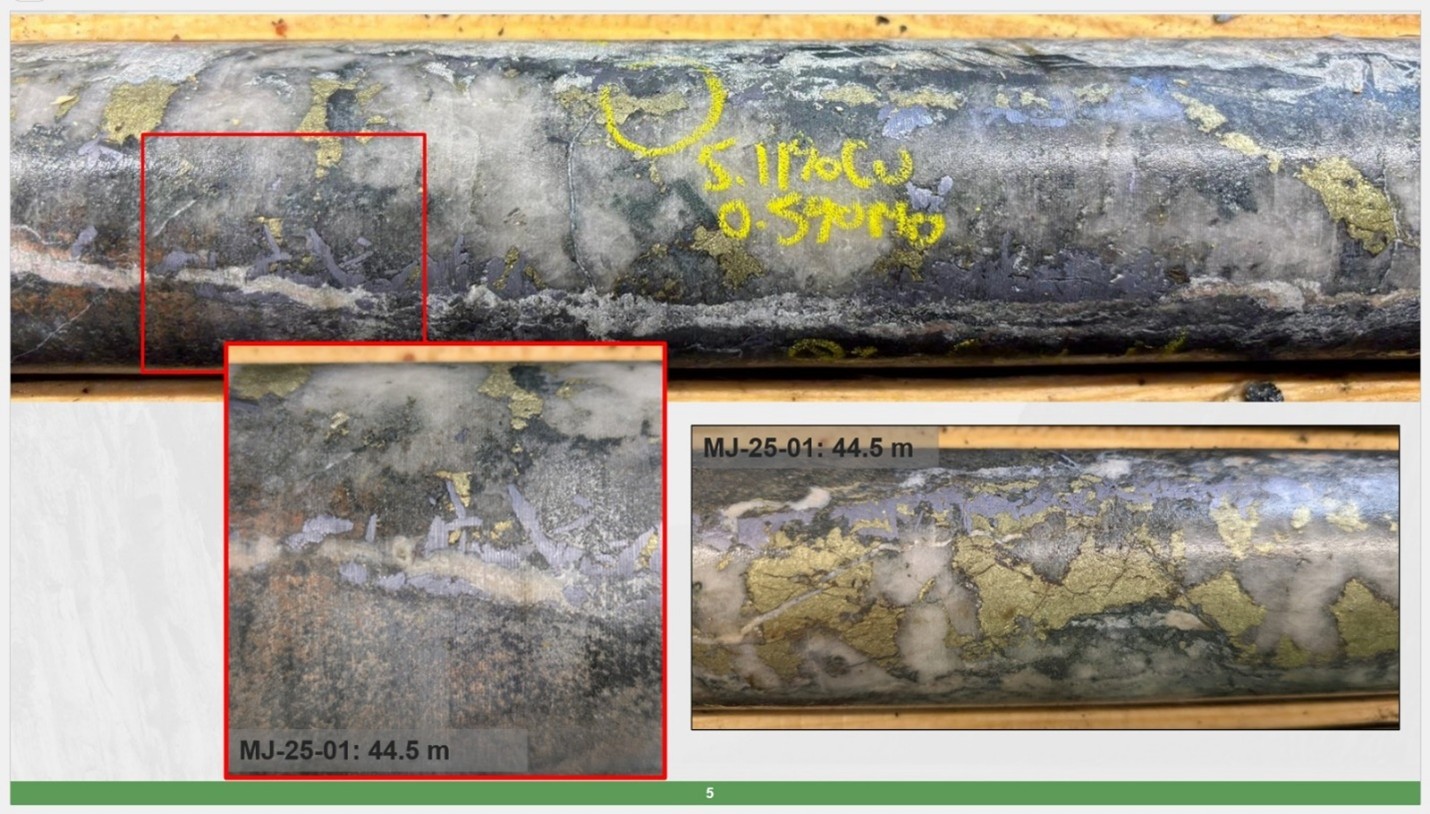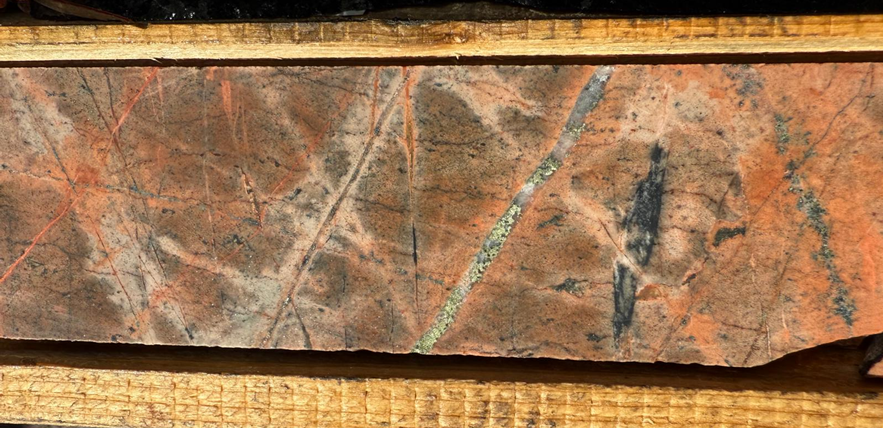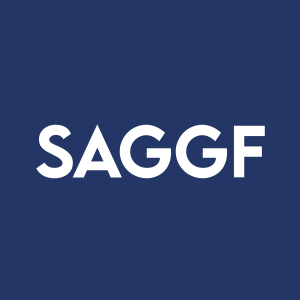Sterling Metals Intersects 359.3m of 0.36% CuEq from Near Surface with Multiple Zones of Bornite Across Preserved Porphyry Copper Deposit in its First Drill Hole at the Newly Renamed Soo Copper Project
- Broad near-surface mineralization with 0.36% CuEq over 359m starting at just 14.3m depth
- Continuous copper mineralization throughout the entire length of the drill hole
- Strategic location with excellent infrastructure access - 20 mins from TransCanada highway, 4 hours from Sudbury
- High-grade intervals including 0.56% CuEq over 75.2m from near surface
- 100% ownership of a 30km hydrothermal copper corridor
- Results from only one drill hole so far, with three holes pending
- True widths of mineralization not yet known
- Early-stage project requiring significant additional exploration
TORONTO, ON / ACCESS Newswire / May 29, 2025 / Sterling Metals Corp. (TSXV:SAG)(OTCQB:SAGGF) ("Sterling" or the "Company") is pleased to announce results from the first of four diamond drill holes (MJ-25-01) recently completed at its newly renamed Soo Copper Project ("Soo Copper" or the "Project"), formerly Copper Road, located in Batchewana Bay, Ontario. The hole has successfully demonstrated a continuous, bulk-tonnage copper-molybdenum-silver-gold ("Cu-Mo-Ag-Au") target, called the GFP Porphyry ("GFP Porphyry"), highlighting the Project's significant mineral potential.
Highlights:
Broad, near-surface zone of high tenor chalcopyrite-bornite copper mineralization starting at 14.3m (overburden to 13.3m) grading
0.36% Copper Equivalent (CuEq) over 359m including0.56% CuEq over the first 75m of this interval (see Table 1).Copper mineralization is associated with a multi-porphyry intrusive complex composed of a newly discovered well mineralized, early syn-mineral stage felsite porphyry, and two intramineral porphyries.
A 130m interval of mafic tuff unit containing large patches of biotite-magnetite-chalcopyrite-bornite mineralization plus chalcopyrite veining beginning at less than 200m vertical depth grading:
0.43% CuEq over 40.4m starting at 249.6m0.56% CuEq over 26.5m starting at 347.0mThe tuff represents an ideal host rock for mineralization, highly permeable and well-altered with preserved bornite-rich mineralization suggesting strong vectoring potential toward the core of a porphyry center.
Copper mineralization encountered throughout the entire length of the drill hole.
Assay results for the remaining three holes are pending and will be released once received.
The Soo Copper Project lies at the intersection of the Midcontinent Rift and the southwestern extension of Kapuskasking Fault Zone, a highly prospective setting historically known for smaller-scale but high-grade copper production at the former Tribag and Copper Corp mines, which anchor either end of the 30km long property. Since their respective mine closures in 1974 and 1972, fragmented ownership and consequent patchwork-type drilling efforts did not encourage the broader scale systematic exploration needed to target a large porphyry copper system1. Seeing this opportunity, one year ago Sterling acquired the Project which one year prior had for the first time seen the consolidation of a contiguous set of mineral licenses covering the most prospective geology and historical mines and prospects. The Project has since undergone comprehensive property wide data compilation, geophysical and geochemical surveys, and ground based examinations, including historical prospect and drill core re-evaluations, focused on identifying evidence for a large-scale porphyry copper system, culminating in the first drill hole of this campaign, which intersected what is believed to be one part of a high-tenor, well-preserved copper porphyry system. The recently completed maiden drill program saw a total of 1,789 metres drilled in four diamond drill holes.
Jeremy Niemi, Senior Vice President Exploration and Evaluation stated, "Copper mineralization, primarily composed of chalcopyrite in both veins and disseminations, extends well above and below the favourable bornite-bearing, biotite-altered sheared tuff unit. This copper-rich mineralization is also hosted in surrounding mafic units and felsic porphyry dykes, especially where strong potassic alteration, either as early biotite or later orthoclase, and A-type veining are present. While the Midcontinent Rift is recognized as a globally significant copper belt, known for its rich endowment of magmatic copper-nickel, sedimentary copper, and native copper deposits, the results of our first drillhole indicate that it also has the potential to yield a significant porphyry copper deposit. We're excited to continue exploring and unlocking the potential of what we believe could be a significant copper system."
Dr. Neil O'Brien, Technical Advisor, added, "At Soo Copper, we are seeing a well-developed and extensive bornite-bearing potassic zone that remains largely preserved from surface downward over nearly 400 metres of drilling and remains open. The discovery of this bornite-rich copper zone hosted by biotite-chlorite altered mafic tuffs that are intruded by a very well veined, early stage felsic porphyry are all critical to our understanding of the greater tonnage and copper grade potential for this porphyry system that previous explorers underestimated. This bodes well for any future mineral resource and mine concentrate products, which could feature high copper tenor and elevated gold content."
Mathew Wilson, CEO and Director, commented, "Over the past 65 years, this Project has seen small-scale but high-grade copper production, with much of the historical focus aimed at chasing narrow, high-grade zones1. We're fortunate to have a team with deep roots in the region-some of whom have worked on this property for decades-which has allowed us to advance the project quickly and effectively.
In less than a year since acquisition, we've gone from a property centered on a single pencil porphyry prospect with limited apparent scale to identifying the key ingredients of a much larger and richer porphyry copper system. With
This is just one hole, but in today's macroeconomic environment, the need for large, bulk-tonnage copper projects in safe jurisdictions like Canada is more urgent than ever-especially one that starts at surface, sits 20 minutes from the TransCanada highway, 4 hours by paved road from Sudbury-a major mining and smelting center, an hour from a deep-water port, the U.S. border, and the city of Sault Ste. Marie."

Figure 1. Chalcopyrite and molybdenite mineralization at 44.5m depth grading

Figure 2. Bornite-chalcopyrite mineralization at 264.9m depth in MJ-25-01 grading

Figure 3. Intensely veined and newly discovered, early stage GFP Porphyry at 267m depth grading
Important Geological Observations in MJ-25-01
Copper mineralization, primarily chalcopyrite, observed from bedrock surface to the end of the hole at 496m depth.
A well developed and preserved, extensive bornite-bearing potassic zone was intersected from surface downwards and remains open.
Bornite mineralization offers high copper tenor with elevated gold grades.
Multiple stages of copper-mineralized porphyry intrusions were observed including an early syn-mineralization stage, as well as two intra-mineral stage porphyries.
Bornite mineralization, adjacent to the GFP syn-mineralization porphyry, was intersected in multiple zones between 249.0m depth and a fault at 388m.
Multiple vein styles, typical of porphyry systems, encountered in first hole:
EB-type: earliest stage, biotite-only
A-type: early stage, commonly irregular and less continuous; quartz +/- potassium feldspar with chalcopyrite and bornite.
B-type: planar and continuous; quartz with molybdenite and/or chalcopyrite.
M-type: magnetite-rich with chalcopyrite within the potassic alteration zone.
G-type: magnetite-rich with chalcopyrite within the inner propylitic alteration zone.
Outward prograde alteration zonation from potassic (early biotite, later orthoclase) to inner propylitic (epidote) to outer propylitic (chlorite) observed and prograde zonation of vein sulphides from inner chalcopyrite-bornite to outer chalcopyrite-pyrite.
Inaugural drilling at the Soo Copper Project by the Company focused on robust targets generated from favourable surface geology and copper geochemistry, strong geophysical (3D IP and Resistivity) anomalies located south and adjacent (within 500m) to core-verified Cu-Mo porphyry mineralization at the Jogran porphyry prospect and the Richards Breccia prospect, a porphyry-related copper breccia (see Figure 5). Results from MJ-25-01 confirm the presence of an extensive porphyry Cu-Mo-Au-Ag mineral system characterized by a favourable high-tenor copper (bornite) potassic core zone.
The early potassic alteration hosting bornite is developed within a foliated permeable tuffaceous mafic volcanic which is cut by strongly veined porphyry dykes. The bornite-rich tuff unit remains open along strike and at depth which provides an exciting target for future exploration drilling.

Figure 5. Hole locations from Sterling Metals inaugural drilling at the Soo Copper Project.1

Figure 6. Cross section showing trace of hole MJ-25-01, mineralization and resistivity from Dias 3D IP survey in the background which matches porphyry alteration and mineralization.
Table 1. Mineralization intervals from MJ-25-01
Zone | Start | End | Length | Cu % | Mo% | Au g/t | Ag g/t | CuEq % |
Overburden | 0 | 13.3 | 13.3 | No sample taken | ||||
Entire Hole | 13.3 | 496.0 | 482.8 | 0.21 | 0.008 | 0.03 | 1.1 | 0.28 |
Including | 14.3 | 373.5 | 359.3 | 0.26 | 0.011 | 0.05 | 1.4 | 0.36 |
Including | 14.3 | 89.5 | 75.2 | 0.38 | 0.021 | 0.09 | 2.4 | 0.56 |
Bornite 1 | 249.6 | 290.0 | 40.4 | 0.36 | 0.002 | 0.05 | 1.9 | 0.43 |
Bornite 2 | 347.0 | 373.5 | 26.5 | 0.47 | 0.003 | 0.07 | 2.0 | 0.56 |
Intervals may not represent true widths which are not yet known and capping has not been applied to grades. CuEq grade calculations for reporting assumes 3-month average metal prices of US
Table 2. Hole locations, direction and final depths.
Hole ID | Easting | Northing | Elevation | Depth (m) | Dip | Azimuth |
MJ-25-01 | 681157 | 5212667 | 421 | 496 | -47 | 250 |
MJ-25-02 | 680744 | 5212719 | 474 | 564 | -54 | 127 |
MJ-25-03 | 681125 | 5212744 | 421 | 354 | -53 | 199 |
CH-25-01 | 680287 | 5212436 | 507 | 375 | -70 | 0 |

Figure 7. Location map of the Soo Copper Road Project along the Trans-Canada Highway, 80km north of Sault Ste. Marie and bridge border crossing to the U.S.
Sampling Procedures - Quality Assurance/Quality Control
Analytical services were provided by Actlabs, which is an independent, CALA- and SCC-accredited analytical services firm registered to ISO 17025 and ISO 9001 standard. Drill core samples were logged and split in half with a diamond core saw. Half-core samples were securely stored at the core logging facility until being delivered to Actlabs North Bay lab by commercial transport. Samples were crushed (< 7 kg) up to
Laboratory QA/QC for the ICP analysis was
Sterling Metals acknowledges that its exploration activities are conducted on the traditional lands of the First Nations and Métis Peoples of the North Shore of Lake Superior. We recognize and respect the longstanding and diverse relationships Indigenous Peoples have with the land and are committed to engaging in a manner that is respectful, transparent, and inclusive.
1 Independent Technical Report entitled "Technical Report on the Copper Road Property", dated April 29, 2024, prepared by Kelly Malcolm, P.Geo., for Sterling Metals Corp.
Qualified Person
Jeremy Niemi, P.Geo., Senior Vice President, Exploration and Evaluation for Sterling Metals has reviewed and approved the technical information presented herein.
About Sterling Metals
Sterling Metals (TSXV:SAG)(OTCQB:SAGGF) is a mineral exploration company focused on large scale and high-grade Canadian exploration opportunities. The Company is advancing the 25,000-hectare Copper Road Project in Ontario which has past production, and multiple breccia and porphyry targets strategically located near robust infrastructure and the 29,000-hectare Adeline Project in Labrador which covers an entire sediment-hosted copper belt with significant silver credits. Both opportunities have demonstrated potential for important new copper discoveries, underscoring Sterling's commitment to pioneering exploration in mineral rich Canada.
For more information, please contact:
Sterling Metals Corp.
Mathew Wilson, CEO and Director
Tel: (416) 643-3887
Email: info@sterlingmetals.ca
Website: www.sterlingmetals.ca
Neither the TSX Venture Exchange nor its Regulation Services Provider (as that term is defined in the policies of the TSX Venture Exchange) accepts responsibility for the adequacy or accuracy of this release.
This news release contains certain "forward-looking information" within the meaning of applicable securities laws. Forward looking information is frequently characterized by words such as "plan", "expect", "project", "intend", "believe", "anticipate", "estimate", "may", "will", "would", "potential", "proposed" and other similar words, or statements that certain events or conditions "may" or "will" occur. These statements are only predictions. Forward-looking information is based on the opinions and estimates of management at the date the information is provided and is subject to a variety of risks and uncertainties and other factors that could cause actual events or results to differ materially from those projected in the forward-looking information. For a description of the risks and uncertainties facing the Company and its business and affairs, readers should refer to the Company's Management's Discussion and Analysis. The Company undertakes no obligation to update forward-looking information if circumstances or management's estimates or opinions should change, unless required by law. The reader is cautioned not to place undue reliance on forward-looking information.
SOURCE: Sterling Metals Corp.
View the original press release on ACCESS Newswire







